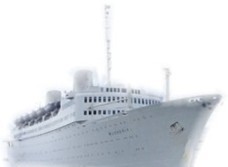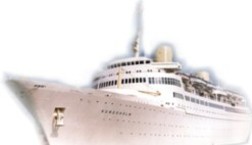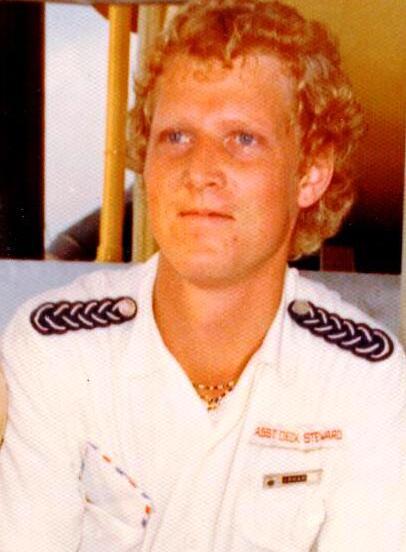I come from Örebro, three hours drive west of Stockholm, where I grew up and where I live today. My original birth place was Gothenburg but my father got a good job offer in Örebro, so we moved there when I was very young. The school start excited me as a child. Throughout the elementary and high school we were four boys that stuck together all the time as a gang of brothers. In senior high school we went separate ways however. My family and I moved to Karlstad where I got a high school diploma in business administration.
After graduation I was terribly tired of school, irresolute about the future and I wanted to leave home. By coincidence I found out there was a seamen’s employment agency in town. I went there and reported my interest. After a medical examination and various immunization shots I went to a photographer to get a passport size photo for my Seamen’s Shipping Book. I was instructed to await a call-up from Gothenburg. As I hadn’t told my parents anything about my plans they got mighty surprised when suddenly I received a letter from the seamen’s employment agency calling me in for a certain date…!
My first job at sea
Equipped with a passport and my cash savings I took the train to Gothenburg. It was a sunny summer day in June and I went directly to Sjöfartshotellet (the “Seafarer’s Hotel”) to book myself a less expensive room. It happened that I had to share the room with a seasoned sailor, an old ruffian…
At the employment agency they told me that the rollcall would start at 9:00 AM the following morning. After a restless night, with all my valuables under the pillow, my roommate woke me up the next morning and he took me to a nearby beer pub to have some breakfast. At 9:00 AM sharp I entered the agency door expectant of what they would offer me.
Huge disappointment..!!!
They had only two jobs available: a position as night cleaner on a ferryboat named Svea (later renamed Saga) and a job as deckhand aboard Thuntank No. 9 in the lake Vänern. A second rollcall was made in the afternoon that same day but nothing new came up. It was just a repetition of the same two job opportunities. Since I did not want to spend another night in Sjöfarthotellet I quickly decided to apply for the position as a night cleaner. The ship’s purser was there at the agency so I introduced myself directly to him. Next I took a taxi to the dock at Skandiahamnen and boarded the ferry. MS Svea operated on the line Gothenburg to Hull in England.
For a night cleaner the work started in the evening with two hours collecting and washing dishes in the bar. The remaining working hours I spent cleaning in the bar lounge, the restaurant and the corridors. I got acquainted with the croupier, a German guy who had late habits, and we became friends onboard with some English youngsters of the same age group as ourselves, who we sometimes visited in their homes when the ferry was berthed overnight in Hull. I had the privilege to bring my own car onboard so we made many excursions.
Aboard the ferry I met Kjell Karlsson who was head waiter then. A few years later he moved on to the Kungsholm, like myself. Kjell revealed to me that he would sign on the Gripsholm in November that year - going on a transatlantic crossing to New York and thereafter a number of cruises to the Caribbean. That was the trigging factor for me..! I asked Kjell which jobs I might apply for on the Gripsholm and how to do it. Without any formal training in service I would probably have to start as a "nisse", a hand or assistant. My application was sent to Broströmia in Gothenburg, i.e. the head office of the Broström Shipping Company.
The Gripsholm
This way I got in contact with the head recruiter known as Captain Tistrand. But I never figured out what sort of a captain he was though...? The interview went well and I was offered a job as hyttnisse, or cabin boy - a hand to the cabin stewards. The duties implied helping the stewards and the stewardesses as well as managing the backstage service pantry. I stayed on that position for eight months, gaining experience as well as a "taste for the sea".
As the months passed I got interested in other jobs onboard. How nice it would be to work out in the fresh air and see where the ship was going! The job on outside deck as an Assistant Deck Steward seemed perfect. Before long I applied for a promotion onboard, and I got it..!
The job was a total contrast to the indoors hotel department. I worked as an Assistant Deck Steward during a North Cape Cruise and some other cruises until I signed off the Gripsholm in September 1969, shortly after an autumn storm. The reason for my signing off was that I had been summoned to fulfill mandatory military training in Sweden. One year later I became a demobbed soldier, free again to do whatever I wanted to do. And of course I contacted the Swedish American Line again! Luckily I did not have to wait long before being assigned a job. This time it was the Kungsholm.
The Kungsholm
When I started on the Kungsholm in 1971, my immediate supervisor was the Deck Steward Ingmar "Andy" Sandell. His assistant Klas Öhman was my workmate and also my roommate. We got along very well and we had our duty station on the Verandah Deck. Another pair of Assistant Deck Stewards was in charge of the Promenade Deck, one deck above ours. And yet another Assistant Deck Steward took care of the snack bar and the mid-ship Sundeck area by the passengers’ outdoor swimming pool.
The passengers could rent deck chairs for an entire cruise and we were managing the reservations and allocations. The sale of deck chairs started already the first evening onboard, immediately after the departure from New York. Many passengers were eager to reserve a deck chair on or near their favorite spot, taking into consideration individual preferences for sunshine or shade, wind and view, etc. We had some hectic hours with the rallying passengers, placing their nametag in the little metal frame of “their” deck chair, signaling that it was taken. The rental fee was 25 USD per chair for a long cruise.
The nametags on the chairs were very useful for us deck stewards. They helped us learn the passengers’ names quickly so that we could greet them in a personal way already from the beginning of a cruise. It was a simple way to make them feel at home and special. Some of the passengers loved being pampered.
Duties
Assistant Deck Stewards worked in two overlapping shifts with rotation every other day. The first shift worked 8:00 AM to 12:00 Noon and 15:00 to 18:00 PM. The second shift was on duty from 9:30 AM to 18:30 PM, with interruption for meals.
Every day we started with dusting and wiping off the deck chairs and deploying them to their correct locations across the deck. They had usually been rounded up over the night so the deck could be rinsed for the next day. Or they had been piled up and lashed down when the sea was rough.
Chair cushions were distributed, to sit on. While serving the guests with blankets and other stuff they asked for we also set up the tea-trolley to serve bouillon (beef broth) at 10:00 AM. That was a much appreciated snack for the passengers and, of course, for us too...! On occasions when the ship was arriving at daybreak into a port with spectacularly beautiful inlet, such as Rio de Janeiro or the archipelago of Stockholm, we served a ”Early risers coffee” out on the deck already from around 6:00 AM.
In the afternoon we set up the trolley again to serve coffee, tea and ice tea along with really delicious Danish pastry, buns and cakes.
The deck stewards were in charge of the two libraries on Veranda Deck, replacing old newspapers when new ones arrived and replenishing the writing tables with stationary such as letter paper, aerogram and airmail envelopes.
On aft Upper Deck, just below Verandah Deck, there were shuffleboard courts and also a tee for golf swing practice. The equipment for those sports needed some looking after and maintenance sometimes, and that was our task to care for.
Moreover, on days with calm sea and weather permitting the deck stewards arranged skeet shooting at 15:00 PM on the aft Upper Deck. We were in charge of three shotguns and ammunition that we kept in safe custody in a gun cabinet in the deck stewards’ store. The guns were of course in need of regular maintenance with coat fat in order to prevent rust. That was our responsibility.
All the things that we had put out during the day needed to be gathered and put back into the deck stores again at the end of each day. And finally, the last deck steward on duty had to go up to the radio room on Promenade Deck and ring the meal bell through the ships speaker system when the dining room opened for dinner at 19:30 PM. Very important!
On long cruises the passengers had a habit of arranging many private cocktail parties. In addition to the deck waiters in Main Lounge, the deck stewards were often called upon for extra help in decorating, serving drinks and snacks. We could be engaged to provide services at lunch parties, evening parties, night parties and even breakfast parties. Those were overtime duties for us, which we carried out on our leisure time while at sea.
The postman
The deck stewards were responsible for the ship’s outgoing mail, which needed stamping, sorting and weighing. And a special form was to be filled in, called a "Paquebote" – an old term for a ship that carries post and passengers. The ship had special stamps with different labels for different cruises, such as, "North Cape Cruise" and "Around South America Cruise", etc.
All the mail was put into a mailbag which was sealed in order to be delivered to the nearest post office ashore as soon as possible by one of the deck stewards. The delivery itself was not always easy, but gave us excellent opportunities to get ashore even in the ship’s remotest and least accessible ports of call. As I remember, the postman was sometimes the only person onboard that got ashore in some of the destinations where the ship was mooring on anchor off the coast. The postman embarked on the first tender to shore and went directly to the local post office. If the captain then decided that the sea was too rough for the passengers’ safe tender traffic to shore it could happen that the entire visit was cancelled. But the ship always had to await the return of the postman before raising anchor.
Gangway watch and quai watch
Another extra duty that we sometimes had to do while in port was to stand gangway watch by the passengers’ gate onboard, or quay watch ashore to assist passengers getting on and off the tender.
I remember one occasion when my colleague Bengt Löfgren and I were the last ones ashore as quay watches. Being only the helmsman and ourselves aboard the last tender back to the ship we were asked if we could help hoisting the tender as it would save much time when we got back to the ship. We said yes without any hesitation. The good spirit of collaboration among crew members that existed across the entire ship is something I remember very well. When the tender was to be hitched I got astonished by the tremendous weight of the blocks that had to be hooked onto the fore and aft of the tender. Then, when we had turned the wires into the correct position the tender was winched up from the sea.
We were standing in life jackets on top of the tender with nothing to hold on to but a rope with a knot. The davits kept winching us higher and higher, all the way to Promenade Deck, and the Kungsholm had already started making speed ahead far below our feet…! I kept telling myself not to look down. That was indeed a breathtaking experience! When we had docked the tender to the ship, stepping down onto the deck, a smiling Captain Bertil Grönberg walked up to us and thanked us. As we were shaking hands he offered us a job in the deck department in case we would ever consider changing profession onboard. Bengt and I probably walked around with a big smile in our faces the rest of that day...
Life onboard
During my final years on the Kungsholm I lived in cabin B2 in the forward section of the ship, next to the carpenter’s workshop. I shared that cabin with different workmates as they were changing each year. My next door neighbors were Decksteward ”Andy” Sandell and Barsteward Peter Baumgardt. My workmates were Klas Öhman, Sten Hovne, Bengt Löfgren, Håkan Askman and Ulf Bjur.
Many of the crew members and waiters that worked on Verandah Deck in the bars, lounges and pantries stayed onboard various years. We became good friends and socialized in our leisure time. At one point in time the deck steward, who was my immediate superior, signed off and then the shipping company decided to eliminate that position onboard. Instead, the chief steward 601, Willie Gebel, was assigned to be my closest boss for the time being.
There was a crew bar on C-deck where we could buy chocolate bars, soft drinks and beer (maximum 5 per day). I remember the small chubby Tuborg bottles that always overflowed when opened. And the older the beer in stock became, the more bottles we were allowed to buy.
A cargo hold in the forward part of the ship was made available to the crew for physical training. There was table tennis too. And on the outside prow deck the crew had a swimming pool and in good weather we could sunbathe around it. Otherwise in our spare time we often played cards, talked and listened to music.
It was always nice to go ashore and do things like sightseeing or go to the beach. In New York we often went to a restaurant first and then to a theatre to watch the new movies. And of course, at the foot of Pier 97 - right across the street from the ship, there were a couple of waterfront establishments which got frequent visits from the crew. It was the Ranger Bar that was operated by Greek owners, and I.J. Gonon’s (nicknamed "the Jew") shop where one could buy anything imaginable…! Music purchases were very important each time in New York given that every crew cabin onboard the Kungsholm was equipped with a private stereo equipment of some sort. We went to Sam Goody’s on 49TH Street where crew members got 30 percent discount on LP-records and 25 percent on tapes.
End of the career
The final cruise for me was a Scandinavia – Europe Cruise and I signed off the ship a day in June 1974. According to the itinerary we were supposed to have visited Copenhagen and a port in Poland before that, but across the Atlantic the ship had run into something. One of the screws was badly damaged and the ship had to go at half speed into Gothenburg for repair at a shipyard.
After my years on the Kungsholm I worked for a short while in the bars on the ferryboat MS Stena Scandinavia, and during that period I lived in Malmö temporarily. I moved back to my hometown Örebro in 1976 and started working in a printing house, which I acquired and took over a year later. I owned and operated the print shop for 17 years before I sold it and got myself an employment instead.
As a retiree I nowadays spend my time on golf, house and garden, and I see my friends as often as I can. I also play some bridge. Once a year since a few years back I go to a reunion with a handful of my past Verandah Deck workmates in Sweden. We sing the Kungsholm Song and share memories together. It is one of my annual highlights.
All the best from
Johan
This story is the result of interviews, exchange and discussion of manuscripts with Johan Jarekull in the summer and autumn of 2016. The text was compiled by Tommy Stark and later edited and translated by Hasse Gustafsson for publication at www.salship.se. Tommy and Hasse worked onboard the Kungsholm at the same time as Johan in the early 1970’s.
|






